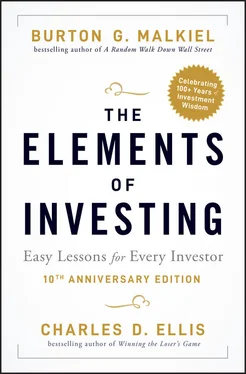Burton G. Malkiel - The Elements of Investing
Здесь есть возможность читать онлайн «Burton G. Malkiel - The Elements of Investing» — ознакомительный отрывок электронной книги совершенно бесплатно, а после прочтения отрывка купить полную версию. В некоторых случаях можно слушать аудио, скачать через торрент в формате fb2 и присутствует краткое содержание. Жанр: unrecognised, на английском языке. Описание произведения, (предисловие) а так же отзывы посетителей доступны на портале библиотеки ЛибКат.
- Название:The Elements of Investing
- Автор:
- Жанр:
- Год:неизвестен
- ISBN:нет данных
- Рейтинг книги:4 / 5. Голосов: 1
-
Избранное:Добавить в избранное
- Отзывы:
-
Ваша оценка:
- 80
- 1
- 2
- 3
- 4
- 5
The Elements of Investing: краткое содержание, описание и аннотация
Предлагаем к чтению аннотацию, описание, краткое содержание или предисловие (зависит от того, что написал сам автор книги «The Elements of Investing»). Если вы не нашли необходимую информацию о книге — напишите в комментариях, мы постараемся отыскать её.
—HARRY MARKOWITZ, Nobel Laureate in Economics 1990
—JONATHAN CLEMENTS, author of —CONSUELO MACK, Anchor and Managing Editor,
The Elements of Investing
The Elements of Investing — читать онлайн ознакомительный отрывок
Ниже представлен текст книги, разбитый по страницам. Система сохранения места последней прочитанной страницы, позволяет с удобством читать онлайн бесплатно книгу «The Elements of Investing», без необходимости каждый раз заново искать на чём Вы остановились. Поставьте закладку, и сможете в любой момент перейти на страницу, на которой закончили чтение.
Интервал:
Закладка:
Over the past several decades, Malkiel's A Random Walk Down Wall Street and Ellis's Winning the Loser's Game have helped millions of people to understand the fundamentals of investing and to reach their financial goals. In The Elements of Investing , Malkiel and Ellis distill their wisdom and experience into a sensible plan for people to save and invest.
Some money managers warn that successful investing can be carried out by only the most sophisticated and talented professionals. And, of course, these managers claim to be members of that small club. Malkiel and Ellis argue that successful investing should not be the province of a select few. Football games are not always won by the best quarterback; they are won in the trenches. Investors have to win the war of blocking and tackling.
The Elements of Investing provides a roadmap that can multiply your savings to reach your financial target. It starts with understanding some basic questions, like: When will you need this money? How well can you tolerate investment risk? The answers to those questions can help you build an appropriate asset allocation between stocks, bonds, and cash.
The approach should be balanced and the investments should be broadly diversified. Most importantly, the authors stress that the investments must be low cost. One certainty about investing is that, for a given return, the more you spend to earn it, the less of it you will keep. The authors conclude that the best way to implement your plan is to invest in low‐cost index funds.
Like blocking and tackling, this approach is certainly not sexy. But, I daresay that most investors would be better off if they followed this strategy. Indeed, it's the kind of approach that we espoused at Vanguard and it has served many clients very well over the years.
Pundits bombard us daily with claims that the old rules no longer apply. They say that people should abandon buy‐and‐hold investing and become more opportunistic. Malkiel and Ellis take umbrage with these claims. To be sure, the pundits have been saying this for many decades. While it may seem intuitive that a smart professional should be able to identify the highs and lows of the market, the majority of such professionals have not been able to achieve the long‐term returns of the disciplined, low‐cost approach that the authors of this book espouse. Do we believe that results will be different in the future? The authors reaffirm the views they expressed in their earlier editions and they provide supporting evidence. Diversification, rebalancing, dollar‐cost averaging, and low‐cost indexing remain the best path to achieve investment success.
The Elements of Investing is a must‐read for all investors—those new to investing and those who have been at it for a while. It's for people of all ages. It should be required reading in high school because the power of compounding is particularly valuable when investors start at a young age. But veteran investors will also benefit from reading this book because it debunks misconceptions and identifies behavioral biases that stand in the way of successful investing. And, just to make sure you do not fall prey to the siren's song of a better way, you should reread this book every several years.
Over the course of my career, I've seen time and again how the principles discussed in this book have helped ordinary people achieve extraordinary results.
George U. “Gus” Sauter
Retired Chief Investment Officer, Vanguard
July 2019
FOREWORD TO ORIGINAL EDITION
In The Elements of Investing , Charley Ellis and Burt Malkiel, two of the investment world's greatest thinkers, combine their talents to produce a remarkable guide to personal finance. Having already written two of the finest books on financial markets, Ellis's Winning the Loser's Game and Malkiel's A Random Walk Down Wall Street , why should the authors revisit the subject of their already classic volumes? The sad fact is that in the cacophony of advice for individual investors, few sane voices are raised. In writing The Elements of Investing , the authors provide an important service to the lay reader, honing their message to the bare essentials by heeding Albert Einstein's dictum that “everything should be made as simple as possible, but not simpler.”
Investors have three tools to deploy in the portfolio management process—asset allocation, market timing, and security selection. Asset allocation involves setting long‐term targets for each of the asset classes in which an investor invests. Market timing consists of short‐term bets against the long‐term asset allocation targets. Security selection deals with the construction of the asset classes that an investor chooses to employ.
Ellis and Malkiel correctly focus on asset allocation since asset allocation accounts for more than 100 percent of investor returns. How can it be that more than 100 percent of returns come from the asset allocation decision? Market timing and security selection involve significant costs in the form of management fees paid to outside advisors and commissions extracted by Wall Street brokers. Such costs ensure that investors will underperform by the totality of investment management costs, which represent transfers from investors to their agents. Hence, the expensive activities of market timing and security selection reduce the returns available for the community of investors and that is the reason asset allocation explains more than 100 percent of investor returns.
Ellis and Malkiel observe that investors consistently make perverse market timing decisions, chasing hot performers and dumping laggards. Study after study of mutual fund trading concludes that investors buy high and sell low, subtracting value with their timing decisions. Ellis and Malkiel sensibly advise investors to adopt a coherent long‐term strategy and stick with it.
Security selection decisions further reduce returns. Ellis and Malkiel cite depressing statistics regarding the failure of the majority of mutual fund managers to exceed the returns of low‐cost, passive, market‐matching index strategies. The documented dismal numbers only begin to capture the enormity of the situation. Ellis and Malkiel cite numbers only for funds that survived, a relatively successful subset of the mutual fund universe. The failures, which as a group produced miserable returns, are nowhere to be measured. Many funds disappeared. The Center for Research in Security Prices collects data on all mutual funds, dead or alive. As of December 2008, the Center tracked 39,000 funds, only 26,000 of which are active. The 13,000 failed funds do not show up in the authors' studies of past returns because the failed funds do not have current track records. (They disappeared, after all.) Considering the experience of mutual funds, dead and alive, reinforces Ellis and Malkiel's advice to take the low‐cost, passive approach.
Of course, even in a slim volume, quibbles arise. I view home ownership more as a consumption good and less as an investment asset. I cast a skeptical eye on Ellis and Malkiel's implicit endorsement of stock picking in their confessions regarding personal success in security selection. (Is it surprising that two of the greatest figures in modern finance would figure out how to beat the market? Yes, they can pick stocks—the rest of us cannot.) I more emphatically recommend Vanguard, which, along with TIAA‐CREF, operates on a not‐for‐profit basis and thereby eliminates the money management industry's pervasive conflict between profit motive and fiduciary responsibility. Quibbles aside, The Elements of Investing delivers an important and fundamentally valuable message.
When I was a doctoral student at Yale in the late 1970s, my dissertation advisor, Nobel laureate James Tobin, suggested that I read A Random Walk Down Wall Street to learn about how markets really work. Burt Malkiel's wonderful book provided a critical foundation for my academic work. When I returned to Yale in the mid‐1980s to manage Yale's endowment, I came across Investment Policy , the predecessor to Winning the Loser's Game . Charley Ellis's marvelous volume informed my approach to investment management in countless ways. Now, Charley Ellis and Burt Malkiel have produced a magnificent primer on investing for all of us. Follow their recommendations and prosper!
Читать дальшеИнтервал:
Закладка:
Похожие книги на «The Elements of Investing»
Представляем Вашему вниманию похожие книги на «The Elements of Investing» списком для выбора. Мы отобрали схожую по названию и смыслу литературу в надежде предоставить читателям больше вариантов отыскать новые, интересные, ещё непрочитанные произведения.
Обсуждение, отзывы о книге «The Elements of Investing» и просто собственные мнения читателей. Оставьте ваши комментарии, напишите, что Вы думаете о произведении, его смысле или главных героях. Укажите что конкретно понравилось, а что нет, и почему Вы так считаете.












